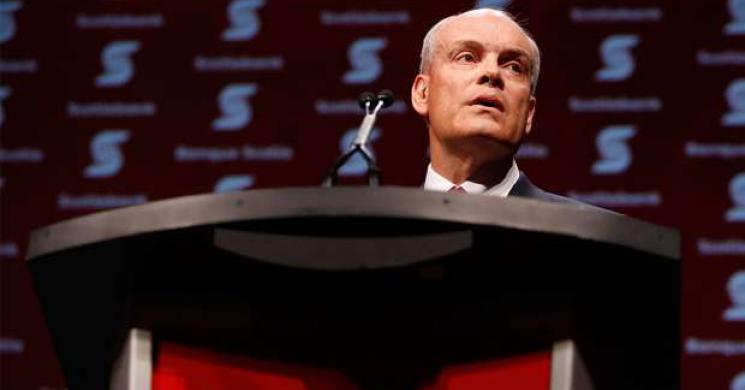
Gold-Fix: ScotiaBank Ordered to Produce Internal Documents
- Soren K
- Canada's Bank of Nova Scotia has been ordered to turn over internal documents
- last week's ruling was the first time a Gold and Silver manipulation case reached the discovery stage
- defendants are Scotia, Barclays PLC, HSBC Holdings PLC, Societe Generale, and Deutsche Bank PLC
- Deutsche settled out of court prior to the ruling
Overview
by Soren K and Vince Lanci, with contributions by Kitco News | Last week Marketslant was fortunate enough to break the story on Judge Caproni’s decision in the Gold Fix manipulation case. The decision is a landmark one and changes the landscape forever in commodity manipulation cases. Simply put, things are just getting started now. And today's news is the first step.
We had received the original document from Kitco News' Chief Editor "Dani". Our goal at that time was to strip out the legalese and make the case particulars plain for readers. What was not discussed were the implications of the Judge’s finding for the Plaintiffs. In light of the first discovery demand, we will try to outline the rulings implications.

Original Story and Ruling HERE
UPDATE:Scotia Bank Gets Tapped for Documents
Today, we learned that Scotia Bank, one of 5 defendant banks in the case, is the first to be ordered to produce internal documents requested by the plaintiffs. These documents go back years covering emails, Instant Message records, internal memorandums, notes from risk meetings and anything the plaintiffs’ attorneys think to ask for that could help their case. Things are about to start getting interesting. Here's why.
Why Things are Different Now
Judge Caproni’s decision was a landmark event for the plaintiffs. It is the first time that a precious metals manipulation case had made it past the “Opinion and Order” stage with a recommendation the case be litigated.
The decision is key in that the plaintiffs will be able for the first time to obtain evidence through discovery and depositions of the defendants. We cannot emphasize that enough. A barrier has been broken that cannot be put back in place. The production of discovery, depositions of witnesses, and other evidentiary processes have never been on the table before are now accessible.
The Defendants Have Risk
Using a different analogy, cans of worms are being opened now. The defendants have real risks now. Risks like: perjury, internal contradictions, contradictions across different firms, and escalation up the corporate ladder (respondeat superior). The defendants know it. And Daniel Brockett, the point man for the plaintiffs knows it.
“They have to produce all the relevant emails and chat room instant messages, however they communicated with each other"--Daniel Brockett, senior partner and litigator at Quinn Emanuel Urquhart & Sullivan LLP
So, to what ends do these requests for documents serve?
What Do the Plaintiffs Hope to Find?
Broadly speaking, we believe the plaintiffs’ attorneys hope to find 2 types of proof from the documents; proof of intent and proof of Sherman Antitrust law violations. In essence: 1) Did they mean it? and 2) Were they working together?
Proving Intent-The Plaintiffs' attorneys will look for evidence of intent. Intent is the most difficult part to prove in any manipulation case. Intent involves knowing what the “manipulator” was thinking leading up to the action. Essentially, did the offender intend to do what he did? There are at least 3 ways of proving intent, none of which are easy.
- The defendant admits it- a product of depositions and/or discovery
- A written audit trail that shows intent exists- discovery
- An email in which a defendant describes why he did a trade- a written admission
- An internal inquiry asking for justification in the scope of the firm's risk- usually involves a superior officer and getting the 2 parties to contradict each other in deposition
- An operational or programming person was made privy to the intent as a function of their duties.- underutilized in our opinion
These are very real risks and if the defendants don’t “get their story straight” (not pejorative), any divergence between word and deed can hurt their credibility and open the door for more aggressive tactics by the plaintiffs.
Proving Antitrust Law Violations-The plaintiffs will seek putative damages under the Sherman Anti-trust act. Specifically under Section 1 governing unlawful restraint of trade. Section 1 delineates and prohibits specific means of anti-competitive conduct. The plaintiffs seek to prove collaboration between 2 or more defendant banks. They will attempt to prove cartel-like behavior between the defendants. The burden of proof here, even with evidence is high.
As stated in Judge Caproni’s decision(emphasis ours):
“Because the Sherman Act does not prohibit [all] unreasonable restraints of trade . . . but only restraints effected by a contract, combination, or conspiracy, . . . [t]he crucial question is whether the challenged anticompetitive conduct stem[s] from independent decision or from anagreement, tacit or express.”
Sherman Anti-Trust Act, Section 1:
"Every contract, combination in the form of trust or otherwise, or conspiracy, in restraint of trade or commerce among the several States, or with foreign nations, is declared to be illegal."
The purpose of the Sherman Act was to preserve a competitive marketplace and protect consumers from abuses. However its more recent applications involve the prevention of cartel operations or monopolies (Wikipedia). Certainly an email from an employee of Scotia Bank to one of its fellow defendants describing what it has done or intends to do would serve this purpose well. But the burden of proof is high.
Even with the uphill battle ahead for the plaintiffs, Brockett was not blowing hot air when he said,
“The ruling is a major victory for the plaintiffs because it upholds the core anti-trust claim against the five fixing banks, and the statutory commodity manipulation claim against the five fixing banks.”
What's Next
- Requests for documents will come in for each defendant.
- Plaintiff attorneys will review the documents and drawn up their plan of attack.
- Depositions of defendant personnel will occur as plaintiffs will look for contradicting and/or corroborating statements of the documents reviewed
- New requests are made
Defendant Legal Tactics
The following are legitimate reasons for difficulty complying with a court order. They are however easily abused.
- Delay: "Those documents have been archived. It will take time to get them"
- Inability to Comply: " ..and some of them have been destroyed as a matter of the statute for keeping records has expired"
- Redirect: "check (former employee) their personal cell phone records"
- No longer works here: "We do not employ that person anymore"
- Trade Secrets: "We cannot give you information that our competitors can use to destroy our business"
- The Peter Gabriel: " I don't remember, I don't recall"
Lesser Evils Get Ranked
The Prisoner's Dilemma grid will come into play, even if nothing was done wrong. There will be triage as well.
- Contempt over perjury
- Perjury over fraud/ intent
- Fine over jail
- Rogue employee over Ceo scandal
Why This is Far from Over
The law operates on facts, not intuition. That means inductive logic, patterns of abuse, and circumstantial evidence don't prove intent.In manipulation cases, intent is the hardest leg to prove of the 3 legged stool concept in law. Judge Caproni said as much in her decision.
From Page 1
Whether the detailed statistical analyses contained in the Complaint reveal ground truth about the activities of the Defendant banks who participated in the Gold Fix or are on the “lies, damn lies and statistics” side of the dichotomy remains to be seen.
In context of her whole statement we take that to mean: "In my judgment you have met the burden of proof and have the right to seek the facts you need to corroborate your statistical conclusions. But statistics are not facts, they are probabilities. You will need facts after today."
DeutscheBank Opted Out

h/t Silverdoctors
Final Word From the Players Themselves
For The Plaintiffs
“So we’ll be able to tell from the communications whether the traders were actually agreeing to manipulate the gold fix price for their own personal gain, which is what we allege.”- Daniel Bockett
They may be able to tell. Doubtful if the communications alone will offer a smoking gun, as cool as that would be. A world of grey exists here.
For The Defendants
"We are unable to comment as the matter is still before the courts,”- Rick Roth for Scotia
We bet you are unable to do a lot of things, like produce documents in a timely manner if at all.
Related Reading
Good Luck
- Email: Sorenk@marketslant.com
- Twitter:@Sorenthek
- Email: vlanci@echobay.com
- Twitter: @VlanciPictures
Read more by Soren K.Group







